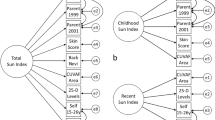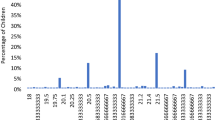Abstract
Quinn et al. reply. In not being able to find the strong association reported by us1 of childhood myopia with night-time ambient lighting before age 2 years, Zadnik et al. and Gwiazda et al. ascribe our results to a tendency of myopic parents to illuminate their children's rooms at night. Family studies of myopia typically have difficulty separating environmental from genetic factors, however, as sib–sib correlations for myopia decrease with increasing age difference2 and within-family refractive similarities decrease with adjustment for the ‘classic’ environmental factors of education and close work3. Thus, shared inter-generational behaviour (such as use of night lighting) cannot be excluded a priori as contributing to any familial association for myopia.
Similar content being viewed by others
Main
There are major differences among the studies. Our subjects were younger (mean age, 8 years) and had a considerably higher myopia prevalence of 28% — itself quite high for a United States population of this young age. Accordingly, early-onset myopes, who ultimately tend to become more severely affected, are overrepresented in our tertiary-care population. Thus, it remains to be determined whether the lack of a daily period of darkness during infancy either accelerates myopia onset or provokes the condition in a subset of children who may be predisposed to a more severe form of the condition.
Neither of the subsequent studies considers possible reporting bias. Our findings received widespread publicity, and parents of myopic children might not accurately report or may even under-report a behaviour they fear could have harmed their children. Misclassification errors may also have been introduced into the later results, from non-cycloplegic childhood refractions in one and from self-reported parental refractions4 in the other.
Our results1 and others demonstrating the influence of lighting on ocular development in animals5 support the notion that disrupting the daily light–dark illumination cycle may affect eye development in children. Rather than offering reassurance to parents at this time, the disparities in the available clinical reports are better directed to guiding the design of future research into the interactions of light, dark and refractive development.
See also K. Zadnik et al. and J. Gwiazda et al.
References
Quinn, G. E., Shin, C. H., Maguire, M. G. & Stone, R. A. Nature 399, 113–114 ( 1999).
The Framingham Offspring Eye Study Group Arch. Ophthalmol. 114, 326–332 ( 1996).
Bear, J. C. in Refractive Anomalies: Research and Clinical Applications (eds Grosvenor, T. & Flom, M. C.) 57–80 (Butterworth-Heinemann, Boston, 1991).
Walline, J. J., Zadnik, K. & Mutti, D. O. Optom. Vision Sci. 73, 376– 381 (1996).
Stone, R. A., Lin, T., Desai, D. & Capehart, C. Vision Res. 35, 1195–202 (1995).
Author information
Authors and Affiliations
Corresponding author
Rights and permissions
About this article
Cite this article
Stone, R., Maguire, M. & Quinn, G. reply: Myopia and ambient night-time lighting. Nature 404, 144 (2000). https://doi.org/10.1038/35004665
Issue Date:
DOI: https://doi.org/10.1038/35004665
Comments
By submitting a comment you agree to abide by our Terms and Community Guidelines. If you find something abusive or that does not comply with our terms or guidelines please flag it as inappropriate.



